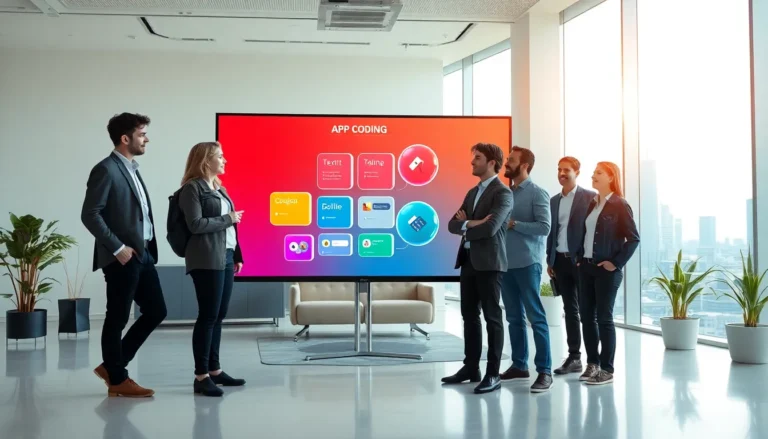In a world where everyone seems to be a budding app developer, it can be rather daunting to keep up with the latest trends and technologies. But fear not, aspiring tech moguls. Enter Bubble, a no-code development platform that transforms your wildest app ideas into reality, no coding skills required. Imagine walking into a dinner party and casually mentioning, “Oh, I developed an app over the weekend,” all while your friends marvel at your newfound tech savviness. Let’s jump into the ins and outs of Bubble app development and see how anyone can join the ranks of app developers with a sprinkle of creativity and a dash of Bubble magic.
Table of Contents
ToggleUnderstanding Bubble: An Overview

Bubble is not just another app development platform: it’s a full-fledged no-code solution that empowers users to create web applications without writing a single line of code. Founded in 2012, Bubble has gained traction for enabling entrepreneurs, startups, and enterprises to build functional MVPs in record time.
Gone are the days of hiring expensive developers or spending countless hours learning complex programming languages. With Bubble, users can drag and drop elements onto their canvas, arranging and customizing them to find the perfect layout. The platform is designed for flexibility, allowing for the integration of APIs and third-party services, making it suitable for a wide array of applications from intricate marketplace solutions to straightforward blogs.
Key Features of Bubble for App Development
Bubble packs a punch with a plethora of features catered to both novice and experienced developers. Here are some key highlights:
Drag-and-Drop Editor
Designing an app shouldn’t feel like rocket science. Bubble’s intuitive drag-and-drop editor allows users to place various elements, like text boxes, images, and buttons, exactly where they want them, no coding or complex interfaces involved.
Responsive Design Capabilities
In an era where mobile usage is skyrocketing, Bubble ensures your apps look great on all devices. Users can create responsive designs that adapt seamlessly to various screen sizes, enhancing the user experience.
Workflow Logic
With Bubble’s workflow editor, creating complex interactions is as simple as a few clicks. Users can define actions based on user inputs, such as submitting forms or clicking buttons, guiding users through a tailored experience.
Extensive Plugin Ecosystem
Whether it’s payment gateways or analytics tools, Bubble’s plugin library is expansive. This allows developers to enhance their apps with added functionalities without starting from scratch.
The Advantages of No-Code Development with Bubble
Why should anyone consider a no-code approach to development? Let’s break it down:
Speed of Development
Building apps with Bubble is significantly quicker than traditional coding methods. The visual interface lets users iterate rapidly, which is perfect for testing ideas and pushing updates without a long wait.
Cost-Effective
Hiring a full development team comes with hefty costs. Bubble eliminates this need, enabling users to create apps within a fraction of the budget. Startups can allocate funds to other vital areas, like marketing, instead of drowning in developer fees.
Accessibility
Even individuals without a technical background can harness Bubble’s power. This democratization of app development means anyone with an idea can potentially change the game.
Getting Started with Bubble App Development
Ready to embark on your Bubble journey? Here’s a step-by-step guide to get started:
Step 1: Sign Up for an Account
Head over to Bubble’s website and create an account. Users can start for free, which is excellent for testing the waters.
Step 2: Explore the Learning Resources
Bubble offers a treasure trove of tutorials and documentation to help new users understand the platform’s features. These resources make it easy to get acquainted with the tools available and kickstart projects.
Step 3: Start Building
Once you’re ready, access the app editor. Begin dragging and dropping elements onto the page, and play around with the workflow options. Don’t hesitate to experiment: the beauty of Bubble lies in its flexibility.
Step 4: Test Your App
Before launching, conduct thorough testing. Bubble allows users to run simulations to verify every element functions as intended, ensuring a smooth user experience once live.
Common Challenges in Bubble Development and Solutions
While Bubble is a fantastic tool, it’s not immune to challenges. Here are some common hurdles and how to overcome them:
Learning Curve
Transitioning to a no-code development environment can be tricky for those accustomed to traditional coding. To tackle this, make use of Bubble’s tutorials and community forums. Learning from others’ experiences can significantly ease the path.
Performance Issues
Sometimes, apps built on any platform can lag. Bubble offers various optimization techniques. Regularly reviewing and refining workflows, limiting excessive elements, and utilizing caching can enhance performance.
Limitations of Customization
While Bubble offers extensive customization options, certain advanced features may require in-depth knowledge or plugin integrations. Keep up-to-date with the Bubble community for innovative solutions and workarounds.
Case Studies: Successful Bubble Apps
Several notable companies have leveraged Bubble to create successful applications, showcasing its capabilities:
AirDev
This software development company uses Bubble to build custom applications rapidly. By maximizing the platform’s features, AirDev has reduced development times significantly.
Qoins
A financial technology app designed to help users pay off debt, Qoins gained traction due to its user-friendly interface built on Bubble. The founders utilized the visual development environment to launch quickly and effectively.
Omnisend
Many adore Omnisend for its email marketing solutions, and it’s one of the prime examples of how Bubble can scale. Launched as a minimal viable product, the app has grown into a robust platform catering to countless startups.










